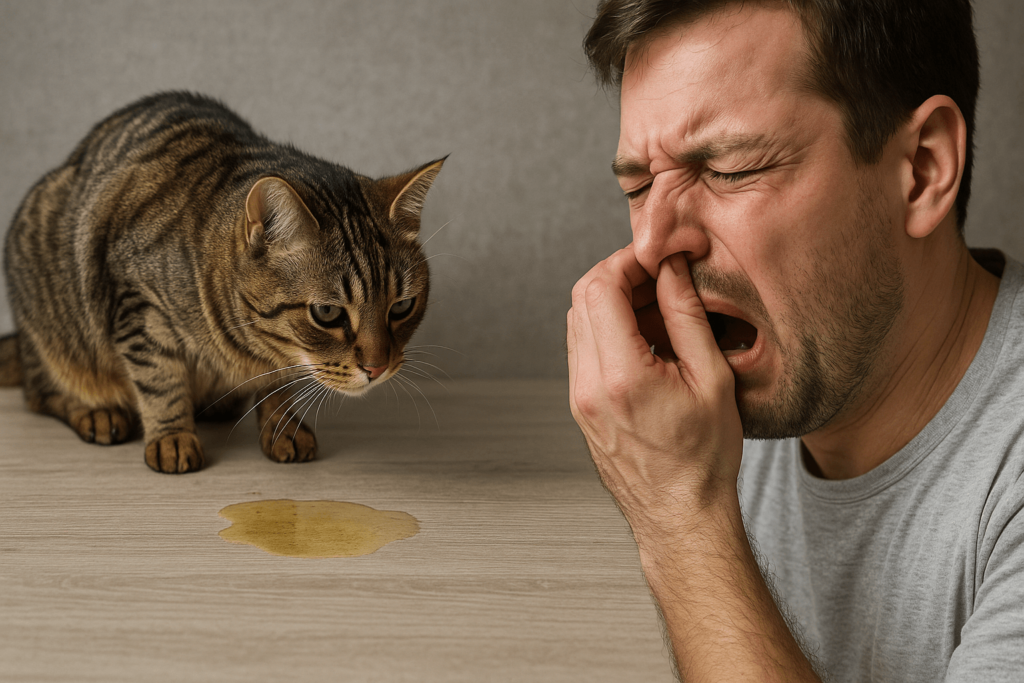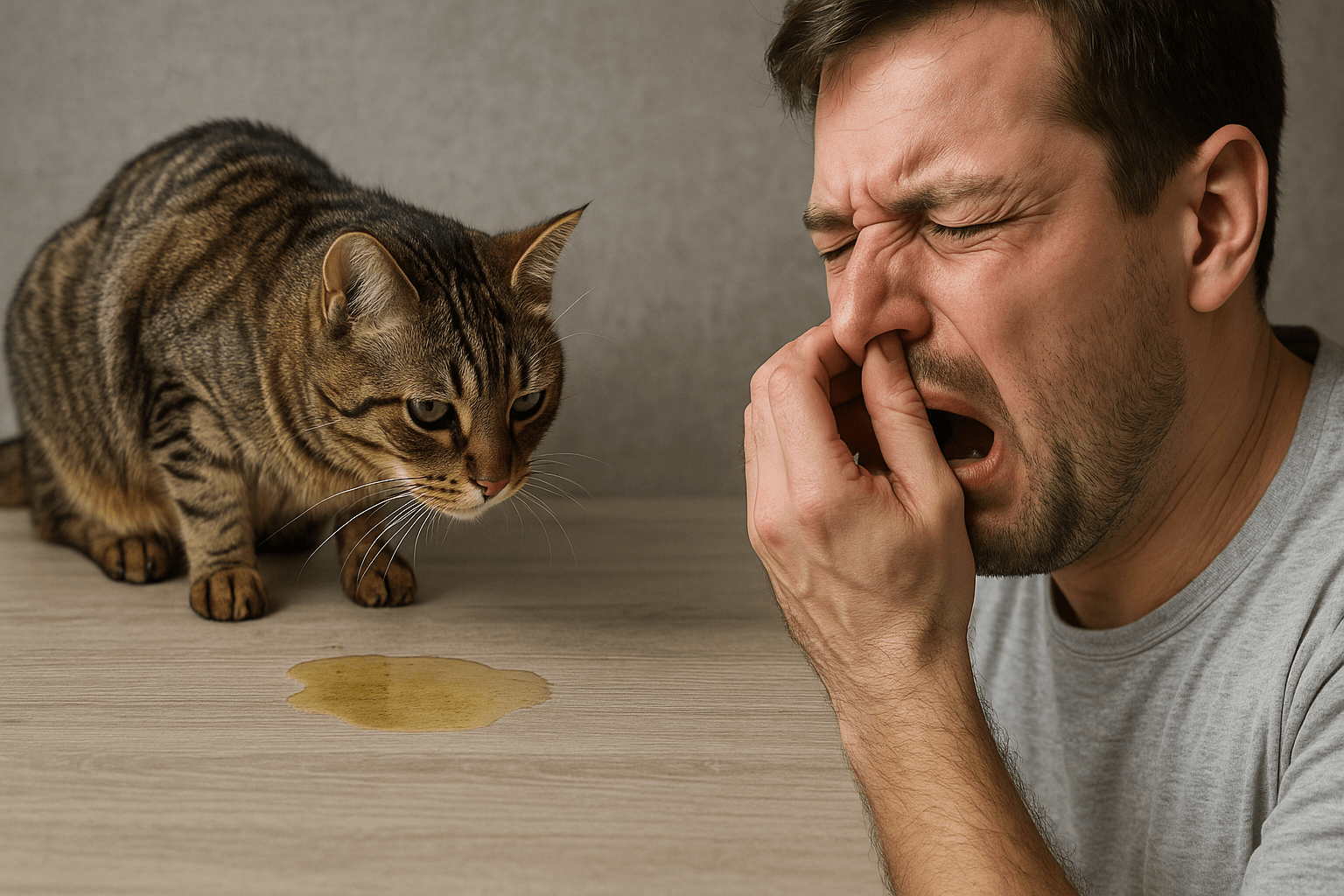Cat Urine Allergy: When Your Feline Friend Triggers Your Sneezes
Cats bring joy, comfort, and purrs into our homes—but for some, their presence comes with a hidden cost: allergic reactions triggered by cat urine. It’s not just dander or saliva. Cat urine contains potent allergens that can linger in the air, cling to surfaces, and provoke sneezing, itchy eyes, and even asthma. If you’re suddenly reacting to your beloved cat—or considering adopting one—understanding cat urine allergy is essential. This isn’t about giving up your pet. It’s about knowing the science, recognizing the signs, and taking smart, effective steps to live harmoniously with both your cat and your health.
Why Cat Urine Triggers Allergic Reactions
Cat urine allergy is often misunderstood. Many assume cat allergies are caused only by dander. But urine is a major—and often overlooked—source of allergens. Here’s why:
Feldspar 1 Protein:
The primary allergen in cats, Fel d 1, is found not just in saliva and skin, but also concentrated in urine. When cats mark territory or squat to pee, they spread it onto fur, litter, and surfaces.Dried Urine Particles Become Airborne:
As urine dries, microscopic particles become airborne and can be inhaled, triggering immune responses in sensitive individuals.Urine Soaks Into Materials:
Carpet, upholstery, and even hardwood floors can absorb urine odor and allergens, creating long-term exposure hotspots.Male Cats Produce More Allergens:
Unneutered males produce significantly higher levels of Fel d 1 in urine due to testosterone influence—making their waste more potent.Litter Box Contamination:
A poorly maintained litter box becomes an allergen factory. Every time your cat uses it, allergens are aerosolized and dispersed into your living space.
Ignoring cat urine as a trigger can lead to worsening symptoms—not because you’re “getting worse” at handling pets, but because allergens are accumulating unseen around your home.

How Cat Urine Allergy Differs from Other Cat Allergies
Not all cat allergies are the same. Understanding the difference between reactions to dander, saliva, and urine helps target solutions effectively.
Dander Allergies:
Cause itchy skin, red eyes, and nasal congestion—symptoms appear quickly after contact with fur or surfaces where fur has been.Saliva Allergies:
Triggered when cats groom themselves and transfer Fel d 1 onto fur. Symptoms often flare after petting or being licked.Urine Allergies:
Often cause more persistent, indoor-wide symptoms—especially in rooms near the litter box. Headaches, chronic congestion, and nighttime breathing issues are common.Timing of Symptoms:
Dander and saliva reactions occur within minutes. Urine-related symptoms may build slowly over hours or days due to lingering particles.Location Patterns:
If your symptoms worsen near the litter box, bathroom, or where your cat sleeps—you’re likely reacting to urine residue, not just general dander.
Recognizing this distinction changes everything. You don’t need to give up your cat—you need to target the source.
Check this guide 👉Natural Cat Allergy Remedies: Best 7 Expert Tips!
Check this guide 👉Can You Develop a Cat Allergy? Best 7 Expert Tips!
Check this guide 👉Cat Allergy Diet: Best 7 Expert Tips!
| Symptom of Cat Urine Allergy | Why It Happens |
|---|---|
| Chronic nasal congestion or post-nasal drip | Inhaled urine particles irritate nasal passages over time. |
| Itchy, watery eyes | Allergens settle on surfaces and become airborne during cleaning or movement. |
| Worsening asthma or wheezing | Urine allergens trigger bronchial inflammation in sensitive lungs. |
| Headaches or fatigue after being home | Prolonged exposure to airborne allergens causes low-grade inflammation. |
| Symptoms improve when away from home | Clear indication that allergens are concentrated indoors, likely from litter or urine spots. |
The Science Behind Fel d 1 in Cat Urine
Fel d 1—the protein responsible for most cat allergies—is produced in sebaceous glands and salivary glands, but it’s excreted in high concentrations through urine. Here’s what you need to know:
Fel d 1 Is Sticky and Long-Lasting:
Once deposited, it binds to dust, fabric fibers, and litter particles, resisting normal cleaning.It’s Not Just About Smell:
You don’t need to smell the urine to react. The allergen is odorless to humans—your nose can’t detect it, but your immune system can.Neutering Reduces Output:
Neutered males show up to 90% less Fel d 1 in urine than intact males. Spaying females also reduces levels slightly.Urination Frequency Matters:
Cats who mark territory (especially males) spread allergens more widely than those who only use the litter box.Kittens Produce Less, But Not None:
Even young cats produce Fel d 1—though levels rise as they mature. Don’t assume a kitten is allergy-safe.
This isn’t about “dirty” cats. It’s about biochemistry. Every cat, even the cleanest, sheds this allergen through urine. The key is control—not elimination.
How to Identify If You’re Allergic to Cat Urine (Not Just Dander)
If you suspect cat urine is your trigger, don’t guess—look for patterns.
Symptoms Worsen Near the Litter Box:
If your nose runs or eyes water every time you walk into the laundry room or bathroom where the box is kept, urine is likely the culprit.Allergy Tests Show Positive for Fel d 1:
Skin or blood tests confirm sensitivity to the protein—but they don’t tell you the source. Track your symptoms in context.Cleaning the Litter Box Triggers Reactions:
Scooping, changing litter, or even opening the box causes immediate sneezing or coughing.Symptoms Persist Despite Bathing Your Cat:
If bathing your cat weekly doesn’t help, the issue isn’t fur—it’s urine residue on floors, carpets, or furniture.You React Even When the Cat Isn’t Present:
If you still have symptoms after leaving the house for a weekend, allergens are embedded in your environment—not just on the cat.
Don’t dismiss this as “just allergies.” Identify the source. Your health depends on it.
Effective Strategies to Reduce Cat Urine Allergens in Your Home
You don’t have to choose between your cat and your well-being. With targeted action, you can drastically reduce exposure.
Use High-Performance Litter Boxes with Lids:
Covered boxes contain aerosolized particles. Choose ones with built-in filters or carbon liners.Scoop Twice Daily and Change Litter Weekly:
Fresh litter = fewer allergens. Never let clumps sit longer than 24 hours.Switch to Low-Dust, Non-Clumping Litter:
Clay and silica dust carry allergens. Opt for natural litters like pine, paper, or wheat-based.Install an Air Purifier with HEPA Filter:
Place one near the litter box and in your bedroom. Run it 24/7 to capture airborne particles.Wash Your Hands Immediately After Handling Litter:
Avoid touching your face until you’ve washed thoroughly. Allergens transfer easily.
Consistency beats intensity. Small daily habits make a bigger difference than occasional deep cleans.
Deep Cleaning for Cat Urine Allergen Removal
Regular cleaning isn’t enough. You need to eliminate embedded allergens from your environment.
Clean Litter Box with Vinegar and Water:
Avoid ammonia-based cleaners—they mimic urine scent and attract cats back. Use white vinegar, which neutralizes odor and allergens.Steam Clean Carpets and Upholstery:
Heat and pressure lift allergens trapped in fibers. Do this every 3–6 months.Wash Bedding and Curtains Weekly in Hot Water:
Cat urine particles cling to fabric. Use detergent with enzyme cleaners to break down proteins.Seal Hardwood Floors and Concrete:
Urine can seep into porous surfaces. Apply a sealant to prevent absorption and make cleaning easier.Replace Old Litter Boxes:
Plastic boxes absorb odor and allergens over time. Replace them every 1–2 years.
This isn’t about perfection. It’s about reduction. Even cutting allergen levels by 70% can turn unbearable symptoms into manageable ones.
Medical and Lifestyle Solutions for Living with Cat Urine Allergy
Sometimes, environmental changes aren’t enough. That’s when medical and lifestyle support step in.
Nasal Corticosteroids or Antihistamines:
Daily use can suppress symptoms without removing your cat. Consult your allergist for safe, long-term options.Allergy Shots (Immunotherapy):
A long-term solution that trains your immune system to tolerate Fel d 1. Requires 3–5 years but offers lasting relief.Wear a Mask When Cleaning the Litter Box:
A simple N95 mask blocks 95% of airborne particles. Make it part of your routine.Keep Your Bedroom Cat-Free:
Designate your bedroom as an allergen-free zone. Close the door. Wash sheets weekly.Consider Neutering or Spaying Your Cat:
This single step can reduce Fel d 1 production by up to 90% in males—and significantly lower overall allergen load.
You don’t have to suffer. Modern medicine and smart habits make living with a cat and cat urine allergy not just possible—but peaceful.
FAQ: Cat Urine Allergy
Can I be allergic to cat urine but not other cat allergens?
Yes. While Fel d 1 is found in multiple sources, some people react primarily to the concentrated form in urine—especially if they’re exposed to litter box dust.
Is it true that hypoallergenic cats don’t cause urine allergies?
No. No cat is truly hypoallergenic. Even Siberians or Balinese produce Fel d 1 in urine. Some produce less, but none produce none.
Does litter type affect allergy severity?
Absolutely. Dusty clumping litters scatter allergens into the air. Natural, low-dust litters reduce airborne particles dramatically.
Can cat urine allergies get worse over time?
Yes. Chronic exposure can sensitize your immune system, making reactions stronger. Early intervention is key.
Will neutering my male cat help my allergy?
Yes—often dramatically. Neutering reduces Fel d 1 in urine by up to 90%. It’s one of the most effective steps you can take.
Live With Your Cat—Without Sacrificing Your Health
Cat urine allergy doesn’t mean saying goodbye to your feline companion. It means seeing your home through a new lens—one where every litter box, every carpet, every fabric surface holds invisible triggers. But knowledge is power. And with the right tools—targeted cleaning, smart products, medical support, and consistent habits—you don’t just survive. You thrive.
Your cat doesn’t choose to produce allergens.
You don’t choose to be allergic.
But together, you can choose how to respond.
Canned Pumpkin for Cat Diarrhea: Best 7 Expert Tips! Natural remedy to firm stools, soothe upset bellies, and support gut health safely.
Can a Cat Give You Scabies? Best 7 Expert Tips! Discover the truth about feline mites, human skin risks, and how to protect yourself—without panic.
Cat Flea vs Human Flea: Best 7 Expert Tips! Discover the truth about bites, species, and how to eliminate infestations for good.
Weird Cat Behaviors: Best 7 Expert Tips! Discover why cats do strange things—and how to understand, not punish, their instincts for a happier home.





